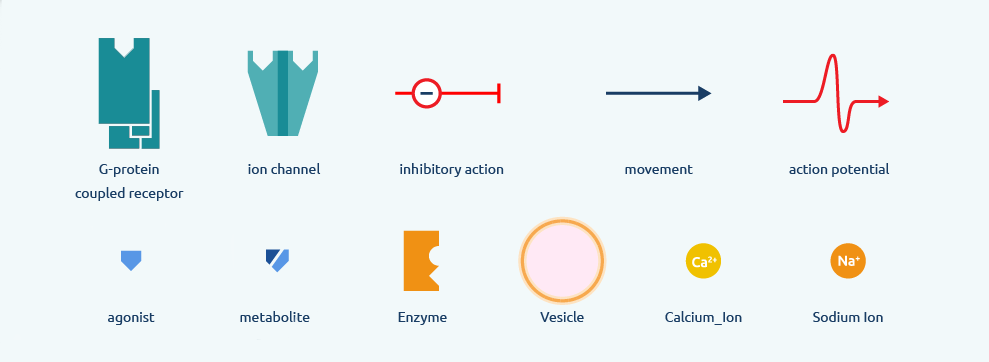Teaching Resource Centre
Topic outline
-
TRC-P (or Teaching Resource Centre - Pharmacology) is a free resource website (and app) for mechanisms of drug action in the context of physiology and pathophysiology. Graphics, animations, graphs, texts, questions, cases and other reference data are provided to enhance the understanding of the user.
In contrast to most other educational material, this resource uses systematic symbols and (interactive) graphics to learn students drug mechanisms. Once students understand the graphical language, new machanisms can literally be understood in a matter of minutes.
-
To learn how to use the TRC effectively, please consult the PDF guide titled "A Brief Guide to Using the TRC." It provides clear instructions and helpful tips for navigating the platform.
-
-
The symbol database plays a vital role in the TRC-p, as it facilitates the creation of illustrations tailored specifically for students. TRC-P distinguishes by other pharmacological learning platforms by using illustrations build from consistant symbol use, rather than learning from text(book). This does not mean that TRC-P does not use text for (additional) explanation (it does!), but the primary understanding of drug mechanisms should be developed via the illustration, by understanding the symbol-language. It usually takes a few hours (2-3) to understand most of the symbol and 'language use'. Once understood, comples compositions with many symbols are understood quickly. Students (and teachers) therefore not only use the TRC-P as a tool to understand new drug mechanisms, but it is also often used as a 'reference library', to quickly look up drug mechanisms that have been learned in the past (and 'forgotten'). And of course, teachers use the TRC-P as a free-to-use resource for illustrations, as all illustrations can be freely used for educational purposes (see "Using & Sharing TRC-P illustrations / Copyright")

-
By exploring the link above, students will better understand how the symbols contribute to the explanation of the illustration 'neuronal synapse'. As a metaphor: the symbols can be seen as individual letters, and when combined, can form words and sentences and create a whole language (all the illustrations on the TRC-P).
Note that students can hover over the illustration for more information on specific symbols, or click on them for more information.
-
A short Quiz is provided to test some of the basic knowledge of the TRC-P's symbol/language use.
-
-
Illustrations may sometimes contain multiple steps, to improve the understanding of (complex) drug mechanisms. An example for Xanthine oxidase inhibitors (gout medication) is provided below. Feel free to hover over the symbols or click on the different steps (1-5) below the illustration to demonstrate the use of this stepwise learning approach used in the TRC-P. Note that the full version on the TRC-P webpage also contains some textual explanation when the illustration itself is not sufficient.
-
The TRC-P includes interactive illustrations that come to life with animations upon clicking. This dynamic feature significantly enhances comprehension compared to static illustrations alone. Take a look at the example provided below to experience it firsthand.
-
To facilitate the exploration and experimentation of various drug dosing regimens, the Pharmacokinetics (PK) simulator has recently added a first version of the PK simulator. In the upcoming year, this simulator will be added to more pages and will include more complex models and many more PK-parameters (e.g. multiple oral dosing under various conditions). Free free to use the current 'try out': click on the link, and on the TRC-website scroll down until the try out is visible.
-
The Centre for Human Drug Research (owners of the TRC-P) stimulates the free use of its illustrations. Teachers can therefore freely use any available illustration. This is promoted by the 'share' option shown near the upper-right corner of each illustration. A popup (see below) will appear, and the illustration can be exported (and even embedded on websites like this) for free.
CHDR only requests to:
1) acklowledge TRC-P via a (small) reference/note that TRC-P was used when an illustration is used. E.g: "source: https://TRC-P.nl"
2) not changing the illustration without approval of CHDR / the TRC-P editorial board. When an illustration is not optimal for your education, feel free to contact CHDR (trc@chdr.nl) and request changes. The TRC-P editorial board will then contact you and discuss possible adaptations.The reason why individual adaptations are not allowed, is simply to avoid that incorrect TRC-P style illustrations will land into the public domain. CHDR strives to provide a platform that is accurate information by high quality illustrations. New illustrations are created throughout the year, but always under supervision of the TRC-P editorial board. We sincerely hope you respect these limitations in making adaptations to the illustrations. Moreover, by contacting the owners, it stimulates to revise existing illustrations or create new illustrations, improving the platform further.

-
Those who are familiar with the 'classic' TRC, will notice many enhancements. Not only in style, but also in interaction and sybol consistency, as well as more self-test questions and new topics. The brief video below illustrates some change in graphical changes.

